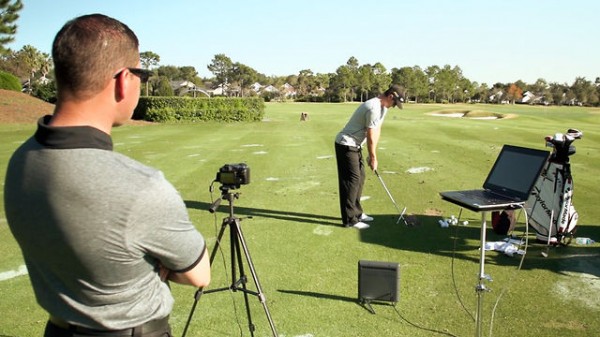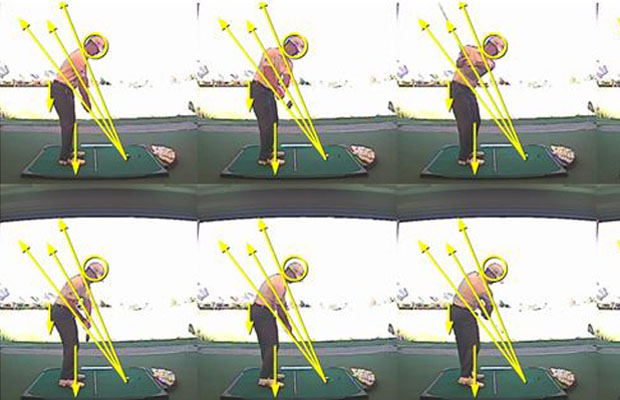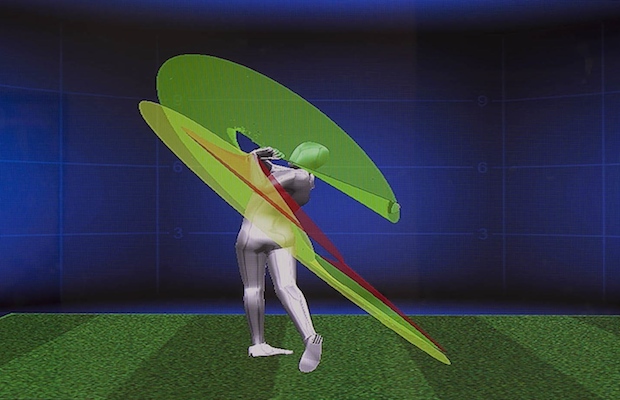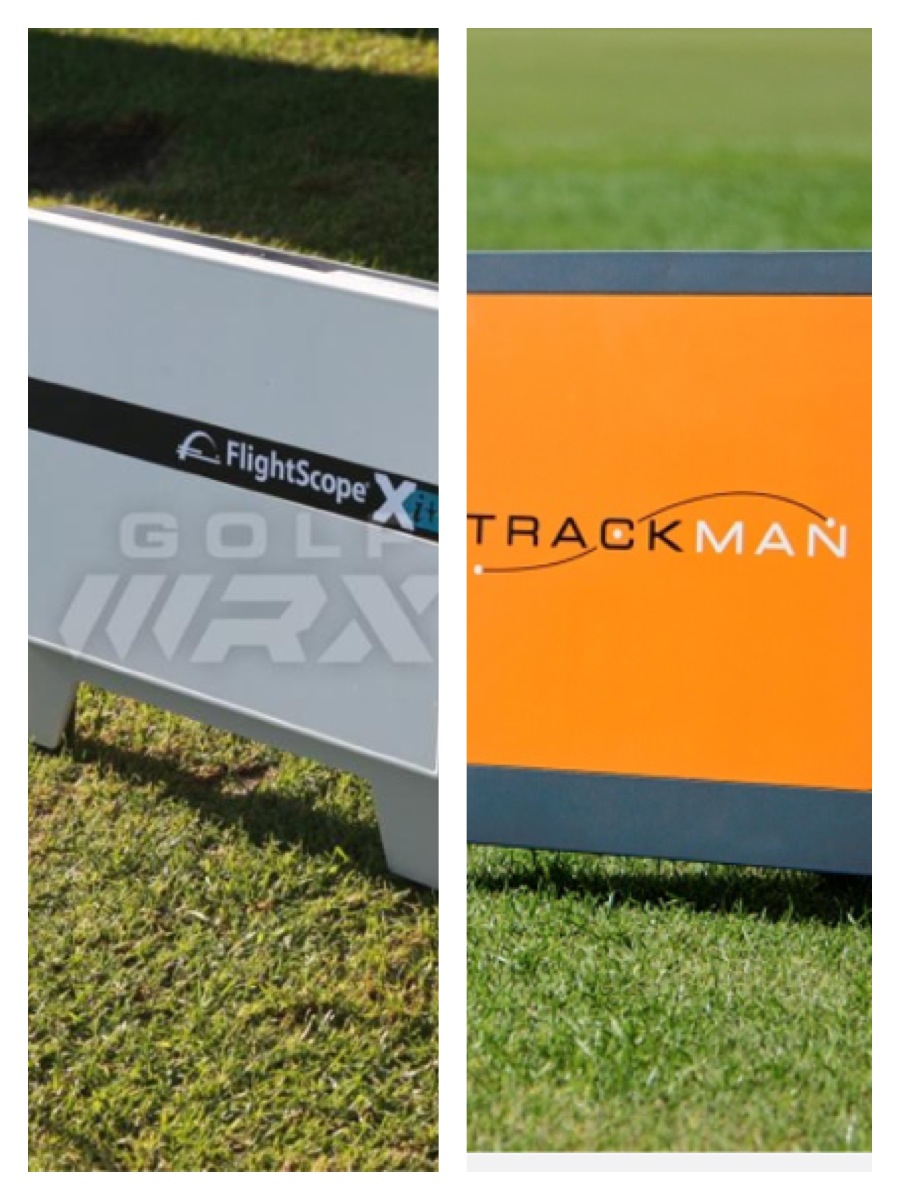Instruction
Using Trackman has made me LESS technical as a teacher

Early in my teaching career, I was told that in order to a successful instructor I had to have great communication skills and possess a talent to describe a highly complex motion in an understandable way to my students. In the 20 years that I’ve been teaching golf, the technologies that instructors now have available to them have only made that lesson more important.
My goal for the swing and its “repair” is to make it as simple as possible for the golfers to understand, whether it is in the articles I write or the lessons I give to my clients. The goal of every teacher is to bridge the gap between giving the student too much information and just the right amount.
With the advent of systems like Trackman and FlightScope, golf instructors are now armed with an enormous amount of data to help them understand what is happening to the Nth degree. While having this information at our fingertips is awesome, it can also cause problems for less experienced teachers. I know from experience that whenever I have more data on hand, it can be very easy to give golfers more information than what is necessary. However, I will tell you that when a teacher truly understands the correlations within the data, it can help instructors make their lessons less technical than ever.
With anything new, there is always a learning curve. But over time, anyone who studies can learn to dissect all the data and assimilate it into his or her teaching style. People tend to criticize what they don’t understand, and using the latest technology will test you in the beginning. But I promise, once you have the “aha” moment, you will be on your way to doing things on the lesson tee in a much more efficient way than ever before.
Years ago, when there was only video, teachers tended to become too position focused, and I think that has carried over to the current crop of young teachers using club and ball flight analyzers. They tend to focus only on pleasing the machine, and sometimes try to force their students into achieving the perfect numbers associated with tour players. While it’s nice to try and copy what better do, it is not the ONLY way a golfer can be successful. Using club and ball flight analyzers in this manner will easily boggle the minds of even the smartest of students.
Above: Justin Rose uses video and Trackman to improve his swing with instructor Sean Foley.
So how do you use club and ball flight analyzers in the best way possible?
In the past, I was overcritical of positions that I thought I saw on camera that might influence factors like the club’s swing direction or the club’s face angle at impact. Now that I can actually see the club’s true path and the face-to-path relationship, I have found myself less focused on what things look like and more focused on what the swing actually produces consistently from the stroke pattern side. No longer do I obsess over things like a student “picking up the club” on the backswing if the downstroke plane is within certain parameters at impact. Often, when I let golfers have some freedom to do what it is natural to them, they achieve a “fix” that is much easier to implement in both the short and long term. There are exceptions to the rules, but generally if I see a decent player whose path and face are under control to some consistent degree, I’m not overly concerned how they got there.
So what do I do if golfer’s angle of attack is a touch down with the driver? As long as the player produces ample distance for the desired level of play and has adequate ball control from side to side, then the player will be fine. What some teachers forget is that the numbers only support or refute what the player is feeling, and are there to give the teacher feedback while making a swing change. The more I understand the data, the better I will get at fixing the one thing that will affect the other seven categories that are a touch off. Find the cause and the effects will take care of themselves.
Over time, instructors will find that they are not so worried about idiosyncrasies shown on video, but more focused on the one simple piece of the “data pie” that will fix it all. From there, it is all about how the player can improve his path, angle of attack, dynamic loft or whatever you as the teacher decide is in the student’s own best way. The best teachers use Trackman or FlightScope in a way that helps players learn through self-discovery. They don’t try to fix every single data point individually, because that makes things way too complicated.
Teachers need video in order to audit positions. They also need club and ball flight analyzers in order to audit the things they cannot see with video. The secret is putting the two mediums together to offer a “fix” for each student regardless of ability level. Use technology to fix the causes, not the effects of a golfer’s swing, and I bet that your students will play better and look forward to more lessons.
Read More Tom Stickney II : What Flightscope and Trackman can tell you (and me)
- LIKE6
- LEGIT0
- WOW0
- LOL0
- IDHT0
- FLOP0
- OB0
- SHANK0
Instruction
The Wedge Guy: The easiest-to-learn golf basic

My golf learning began with this simple fact – if you don’t have a fundamentally sound hold on the golf club, it is practically impossible for your body to execute a fundamentally sound golf swing. I’m still a big believer that the golf swing is much easier to execute if you begin with the proper hold on the club.
As you might imagine, I come into contact with hundreds of golfers of all skill levels. And it is very rare to see a good player with a bad hold on the golf club. There are some exceptions, for sure, but they are very few and very far between, and they typically have beat so many balls with their poor grip that they’ve found a way to work around it.
The reality of biophysics is that the body moves only in certain ways – and the particulars of the way you hold the golf club can totally prevent a sound swing motion that allows the club to release properly through the impact zone. The wonderful thing is that anyone can learn how to put a fundamentally sound hold on the golf club, and you can practice it anywhere your hands are not otherwise engaged, like watching TV or just sitting and relaxing.
Whether you prefer an overlap, interlock or full-finger (not baseball!) grip on the club, the same fundamentals apply. Here are the major grip faults I see most often, in the order of the frequency:
Mis-aligned hands
By this I mean that the palms of the two hands are not parallel to each other. Too many golfers have a weak left hand and strong right, or vice versa. The easiest way to learn how to hold the club with your palms aligned properly is to grip a plain wooden ruler or yardstick. It forces the hands to align properly and shows you how that feels. If you grip and re-grip a yardstick several times, then grip a club, you’ll see that the learning curve is almost immediate.
The position of the grip in the upper/left hand
I also observe many golfers who have the butt of the grip too far into the heel pad of the upper hand (the left hand for right-handed players). It’s amazing how much easier it is to release the club through the ball if even 1/4-1/2″ of the butt is beyond the left heel pad. Try this yourself to see what I mean. Swing the club freely with just your left hand and notice the difference in its release from when you hold it at the end of the grip, versus gripping down even a half inch.
To help you really understand how this works, go to the range and hit shots with your five-iron gripped down a full inch to make the club the same length as your seven-iron. You will probably see an amazing shot shape difference, and likely not see as much distance loss as you would expect.
Too much lower (right) hand on the club
It seems like almost all golfers of 8-10 handicap or higher have the club too far into the palm of the lower hand, because that feels “good” if you are trying to control the path of the clubhead to the ball. But the golf swing is not an effort to hit at the ball – it is a swing of the club. The proper hold on the club has the grip underneath the pad at the base of the fingers. This will likely feel “weak” to you — like you cannot control the club like that. EXACTLY. You should not be trying to control the club with your lower/master hand.
Gripping too tightly
Nearly all golfers hold the club too tightly, which tenses up the forearms and prevents a proper release of the club through impact. In order for the club to move back and through properly, you must feel that the club is controlled by the last three fingers of the upper hand, and the middle two fingers of the lower hand. If you engage your thumbs and forefingers in “holding” the club, the result will almost always be a grip that is too tight. Try this for yourself. Hold the club in your upper hand only, and squeeze firmly with just the last three fingers, with the forefinger and thumb off the club entirely. You have good control, but your forearms are not tense. Then begin to squeeze down with your thumb and forefinger and observe the tensing of the entire forearm. This is the way we are made, so the key to preventing tenseness in the arms is to hold the club very lightly with the “pinchers” — the thumbs and forefingers.
So, those are what I believe are the four fundamentals of a good grip. Anyone can learn them in their home or office very quickly. There is no easier way to improve your ball striking consistency and add distance than giving more attention to the way you hold the golf club.
More from the Wedge Guy
- The Wedge Guy: Golf mastery begins with your wedge game
- The Wedge Guy: Why golf is 20 times harder than brain surgery
- The Wedge Guy: Musings on the golf ball rollback
- LIKE85
- LEGIT13
- WOW6
- LOL1
- IDHT0
- FLOP4
- OB1
- SHANK8
Instruction
Clement: Stop ripping off your swing with this drill!

Not the dreaded headcover under the armpit drill! As if your body is defective and can’t function by itself! Have you seen how incredible the human machine is with all the incredible feats of agility all kinds of athletes are accomplishing? You think your body is so defective (the good Lord is laughing his head off at you) that it needs a headcover tucked under the armpit so you can swing like T-Rex?
- LIKE0
- LEGIT2
- WOW2
- LOL0
- IDHT0
- FLOP0
- OB0
- SHANK2
Instruction
How a towel can fix your golf swing

This is a classic drill that has been used for decades. However, the world of marketed training aids has grown so much during that time that this simple practice has been virtually forgotten. Because why teach people how to play golf using everyday items when you can create and sell a product that reinforces the same thing? Nevertheless, I am here to give you helpful advice without running to the nearest Edwin Watts or adding something to your Amazon cart.
For the “scoring clubs,” having a solid connection between the arms and body during the swing, especially through impact, is paramount to creating long-lasting consistency. And keeping that connection throughout the swing helps rotate the shoulders more to generate more power to help you hit it farther. So, how does this drill work, and what will your game benefit from it? Well, let’s get into it.
Setup
You can use this for basic chip shots up to complete swings. I use this with every club in my bag, up to a 9 or 8-iron. It’s natural to create incrementally more separation between the arms and body as you progress up the set. So doing this with a high iron or a wood is not recommended.
While you set up to hit a ball, simply tuck the towel underneath both armpits. The length of the towel will determine how tight it will be across your chest but don’t make it so loose that it gets in the way of your vision. After both sides are tucked, make some focused swings, keeping both arms firmly connected to the body during the backswing and follow through. (Note: It’s normal to lose connection on your lead arm during your finishing pose.) When you’re ready, put a ball in the way of those swings and get to work.

Get a Better Shoulder Turn
Many of us struggle to have proper shoulder rotation in our golf swing, especially during long layoffs. Making a swing that is all arms and no shoulders is a surefire way to have less control with wedges and less distance with full swings. Notice how I can get in a similar-looking position in both 60° wedge photos. However, one is weak and uncontrollable, while the other is strong and connected. One allows me to use my larger muscles to create my swing, and one doesn’t. The follow-through is another critical point where having a good connection, as well as solid shoulder rotation, is a must. This drill is great for those who tend to have a “chicken wing” form in their lead arm, which happens when it becomes separated from the body through impact.
In full swings, getting your shoulders to rotate in your golf swing is a great way to reinforce proper weight distribution. If your swing is all arms, it’s much harder to get your weight to naturally shift to the inside part of your trail foot in the backswing. Sure, you could make the mistake of “sliding” to get weight on your back foot, but that doesn’t fix the issue. You must turn into your trial leg to generate power. Additionally, look at the difference in separation between my hands and my head in the 8-iron examples. The green picture has more separation and has my hands lower. This will help me lessen my angle of attack and make it easier to hit the inside part of the golf ball, rather than the over-the-top move that the other picture produces.


Stay Better Connected in the Backswing
When you don’t keep everything in your upper body working as one, getting to a good spot at the top of your swing is very hard to do. It would take impeccable timing along with great hand-eye coordination to hit quality shots with any sort of regularity if the arms are working separately from the body.
Notice in the red pictures of both my 60-degree wedge and 8-iron how high my hands are and the fact you can clearly see my shoulder through the gap in my arms. That has happened because the right arm, just above my elbow, has become totally disconnected from my body. That separation causes me to lift my hands as well as lose some of the extension in my left arm. This has been corrected in the green pictures by using this drill to reinforce that connection. It will also make you focus on keeping the lead arm close to your body as well. Because the moment either one loses that relationship, the towel falls.


Conclusion
I have been diligent this year in finding a few drills that target some of the issues that plague my golf game; either by simply forgetting fundamental things or by coming to terms with the faults that have bitten me my whole career. I have found that having a few drills to fall back on to reinforce certain feelings helps me find my game a little easier, and the “towel drill” is most definitely one of them.
- LIKE12
- LEGIT2
- WOW2
- LOL0
- IDHT0
- FLOP2
- OB0
- SHANK8
-

 19th Hole1 week ago
19th Hole1 week agoDave Portnoy places monstrous outright bet for the 2024 Masters
-

 19th Hole3 weeks ago
19th Hole3 weeks agoThings got heated at the Houston Open between Tony Finau and Alejandro Tosti. Here’s why
-

 19th Hole1 week ago
19th Hole1 week agoTiger Woods arrives at 2024 Masters equipped with a putter that may surprise you
-

 19th Hole2 weeks ago
19th Hole2 weeks agoReport: Tiger Woods has ‘eliminated sex’ in preparation for the 2024 Masters
-

 19th Hole5 days ago
19th Hole5 days agoTwo star names reportedly blanked Jon Rahm all week at the Masters
-

 19th Hole4 days ago
19th Hole4 days agoNeal Shipley presser ends in awkward fashion after reporter claims Tiger handed him note on 8th fairway
-

 19th Hole3 days ago
19th Hole3 days agoReport: LIV Golf identifies latest star name they hope to sign to breakaway tour
-

 19th Hole2 weeks ago
19th Hole2 weeks agoAddiction, spinal fusion, and scam artists – Everything Anthony Kim revealed in candid interview with David Feherty























dman
Jan 14, 2014 at 6:20 pm
thanks for posting this! i have been thinking this for some time now. i recently got a lot better, because i finally understood what impact was supposed to feel like. for years i had been seeing instructors that were helping me get in the ‘right positions’, and while this undoubtedly has a purpose, it left me very frustrated as to why i wasn’t getting better with a good looking swinging. at the end of the day, it’s the position of the club at impact that matters! i think lessons should begin with and always refer to what is happening at the bottom of the swing and how that effects the ball. i never understood it until recently, and i was a scratch golfer!
Pebo
Dec 4, 2013 at 7:42 pm
I call my Trackman “The Truth” starting there makes learning simple. Geometry and Physics. Love this article. Video is two dimensions of a three dimension motion. I am old enough to remember when teachers using video were nut cases….. Progress is sometimes slow.
Martin
Dec 4, 2013 at 6:54 pm
Great article! I did a fitting of a new 5wood and I really got good numbers according to the fitter on the trackman. My swingpath (I believe it was) was around 2-3 (he said that was a sign of me coming from the inside) and my face angle was 4-6 (I might be mixing the two datas here, sorry for the confusion) and it produced a nice draw. He said that the launch angle was a little low, I think it was 10-11, but I noticed that the smash factor was really close to 1.50(on the last shot it actually was 1.50). After reading your article I wonder how my low launch still “is the correlation between the club-head speed he or she delivers at impact and the subsequent speed imparted to the ball when the it leaves the club. This gives a rough estimate of how “efficient” a golfer is at impact”. Would be really interesting to hear your opinion on this thing. Really like your articles!
Damon
Dec 4, 2013 at 4:08 pm
Great article! I find with my students on Trackman that using visual markers like alignment sticks to help get a player focused on start lines and using more feel-oriented thoughts helps tremendously with self correcting numbers. It’s such a misconception that Trackman is overly-technical and promotes chasing zeros and perfect numbers. Really refreshing to see an instructor on the same page!
tom stickney
Dec 4, 2013 at 6:48 pm
Thank you for your note!
Scott Anderson
Dec 4, 2013 at 6:56 am
Makes perfect sense…having been self taught I know the relative importance of positions in my swing but I also know that I’ve worked thru a dozen positions during my transition to being a better player and more than one set of positions allowed me to strike the ball properly. Never have totally erased my Furyk. At the top” but I don’t obsess about it anymore because I consistently strike the ball.
Graeme
Dec 3, 2013 at 8:16 am
Fantastic article.
Being position focused and not paying much attention to ball flight is a bad combination.
Ian Pont
Dec 2, 2013 at 4:25 pm
Interesting article that impacts on many sports where coaches use technical feedback to fuel outcome improvements.
What struck me about reading this was that it is HOW you feed the information to a student rather than WHAT information you feed that student, that becomes the most important factor. It isn’t the sheer amount of data analysis that’s vital. Instead, it is a complicit understanding by the coach to interpret the information suitable for the student – and this can only be done with training drills that help the student to actually make impactful changes.
Technique, and thereby the processes of the movement, drive improved skill levels through greater acquisition. However, it is the drills that create the outcome the student seeks.
It is clearly a mistake for any coach to overload a student with information. The information should only ever be enough for the student to ‘buy in’ to the changes needed and how they are achieved.
Paralysis by analysis, is a common fault of coaches who are unable to differentiate what a student needs versus what they want to share. Technology often skews a coach towards unnecessary inputs.
Simply put, develop a process that is robust and teach that. Within that framework, flexibility of student can be applied through benchmarking, rather than by a definitive solution. However, any anomaly doesn’t disprove a framework. It merely underscores the fact that there is sometimes more than one way to get to a great outcome.